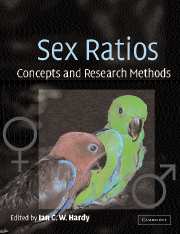Book contents
- Frontmatter
- Contents
- List of contributors
- Preface and acknowledgements
- Part 1 Sex ratio theory
- Part 2 Statistical analysis of sex ratio data
- Part 3 Genetics of sex ratio and sex determination
- Part 4 Animal sex ratios under different life-histories
- Chapter 10 Sex ratios of parasitic Hymenoptera with unusual life-histories
- Chapter 11 Sex ratio control in arrhenotokous and pseudo-arrhenotokous mites
- Chapter 12 Aphid sex ratios
- Chapter 13 Sex ratios in birds and mammals: can the hypotheses be disentangled?
- Chapter 14 Human sex ratios: adaptations and mechanisms, problems and prospects
- Part 5 Sex ratios in plants and protozoa
- Part 6 Applications of sex ratios
- Index
- References
Chapter 14 - Human sex ratios: adaptations and mechanisms, problems and prospects
Published online by Cambridge University Press: 06 August 2009
- Frontmatter
- Contents
- List of contributors
- Preface and acknowledgements
- Part 1 Sex ratio theory
- Part 2 Statistical analysis of sex ratio data
- Part 3 Genetics of sex ratio and sex determination
- Part 4 Animal sex ratios under different life-histories
- Chapter 10 Sex ratios of parasitic Hymenoptera with unusual life-histories
- Chapter 11 Sex ratio control in arrhenotokous and pseudo-arrhenotokous mites
- Chapter 12 Aphid sex ratios
- Chapter 13 Sex ratios in birds and mammals: can the hypotheses be disentangled?
- Chapter 14 Human sex ratios: adaptations and mechanisms, problems and prospects
- Part 5 Sex ratios in plants and protozoa
- Part 6 Applications of sex ratios
- Index
- References
Summary
Summary
This chapter considers the factors influencing population birth sex ratios and variations of the sex ratio within populations, together with adaptive interpretations of these effects and the mechanisms underlying them. Adaptations and mechanisms for birth sex ratios are poorly understood, whereas variation in the sexual biasing of postnatal investment is more clearly adaptive. Social and demographic factors influencing birth sex ratios and postnatal investment include: parental status (the Trivers-Willard effect), father's age, birth order and local resource enhancement and competition. Complex effects are expected since many causal factors may interact at different times during offspring dependency. Possible mechanisms for control of the birth sex ratio include: the proportion of X and Y sperm in ejaculates; the relative success of X and Y sperm in fertilization, as determined by hormonal changes over the menstrual cycle interacting with the time of insemination and coital frequency; and embryonic mortality. Prospects for new work emerge from the following analyses: mechanisms for the Trivers-Willard effect (X and Y sperm proportions in ejaculates, coital frequency, embryonic mortality, family size and paternal age; predicting adaptation from proposed mechanisms and ancestral states; relationships between status, reproductive success and its variance; measuring status more realistically; and marginal return as the correct measure for predicting investment.
Introduction
The peculiar fascination with the human sex ratio at birth has a number of sources.
- Type
- Chapter
- Information
- Sex RatiosConcepts and Research Methods, pp. 287 - 312Publisher: Cambridge University PressPrint publication year: 2002
References
- 53
- Cited by



